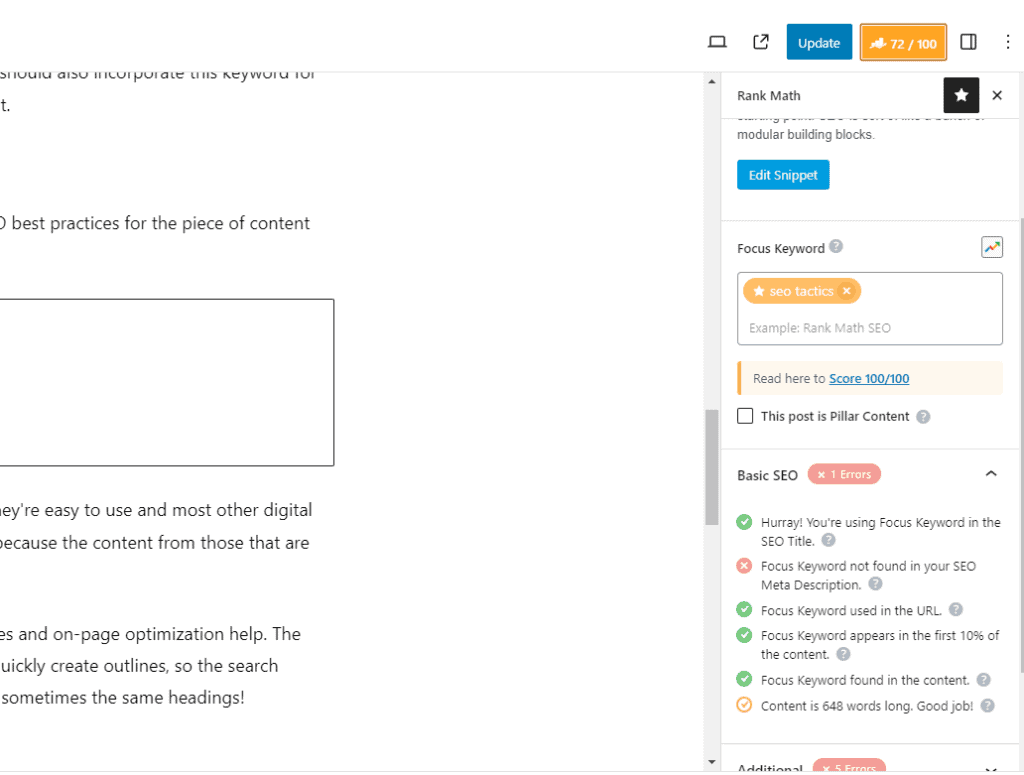
Actionable SEO Tactics That Can Lead To Traffic Growth
There are countless ways to use SEO to your advantage, but the fundamentals are a good starting point. SEO is sort of like a bunch of modular building blocks.
If you master the basics and then use them as a lunch pad, you’ll be surprised at what happens to your traffic when they’re all set up and working together correctly.
1. Keyword Research
What if you could target the right topics that you know people are searching for? You can with keyword research.
This is one of the most powerful concepts in SEO, yet it is one that most bloggers don’t really understand at a deep level. They will either over-optimize for keywords or take the opposite approach and disregard it entirely.
It’s actually pretty simple to do. Start by identifying the keywords your target audience uses to search for content like yours. Free keyword research tools make this process very simple.
Use tools like Googles Keyword Planner, SEMrush, or Ahrefs to find relevant keywords with high search volume and low competition. Then produce high-quality content about topics you find during this process.
Suggested Resources:
2. High-Quality Content
Another fundamental SEO tactic is creating high-quality content. This is arguably the most important SEO tip to remember of all the ones listed here.
Google has officially published something they’re calling the “Helpful Content System” which rewards those who create high-quality and helpful content. It also penalizes sites that aren’t helpful which makes it harder for them to get traffic.
It is possible to recover from a hit from the Helpful Content Update, but that’s a completely standalone guide. But the easiest way to avoid getting hit is to simply create high-quality content from the start.
Create content that’s valuable, informative, and better than what’s currently ranking. Content quality is a major ranking factor, and search engines prioritize content that fulfills users’ search intent.
This tip sounds very simple but many website owners get it completely wrong. They over-optimize their posts which end up being written more for the intention of ranking on Google than being helpful to readers.
When I’m explaining this concept to clients I work with through my agency, Trendline SEO, I give them one simple piece of advice: put yourself in your reader’s shoes and honestly ask yourself, “If you got matched with your page after looking for the page’s focus keyword, would you be truly happy you were matched with that page?”
After going through that exercise, the client usually gives me the green light to modify or rewrite the content on the page.
Suggested Resources:
3. Optimize Your Posts
On-page optimization is something you’ll hear me talk about quite a bit throughout this site. At the core it’s pretty simple. When you’re producing a post or page for your blog you’ll want to make sure each one is optimized for SEO by including:
- A compelling title with your main keyword
- Meta descriptions that encourage clicking
- Alt text for images using relevant keywords
- Short and descriptive URLs
- Internal links to your other content
Remember your keyword research from the previous step? You should also incorporate this keyword for naturally into your titles, headings, and throughout your content.
SEO tools can help in this process.
I suggest first starting with the Rank Math plugin to identify SEO best practices for the piece of content you’re trying to rank. It lives directly within your WordPress post editor and provides very simple yet helpful information about how to improve your on-page SEO.

You’ll also find Frase.io and MarketMuse in my tech stack. These tools help you understand what optimizations your content can benefit from, such as additional keywords to add and how the post should be structured.
They’re easy to use and most other digital markets don’t use them. I like tools that aren’t widely adopted because the content from those that are usually looks and sounds the same.
For example, Surfer SEO is a great tool that recommends outlines and on-page optimization help. The downside is that most of the SEO community uses this tool to quickly create outlines, so the search results are riddled with the same template, structure, and EVEN sometimes the same headings!
4. Improve Page Speed
Site speed is a ranking factor so taking the time and effort to speed up WordPress should be a priority from the start.
If you’re at all familiar with the tech stack I use to set up my websites, then you’ll be very aware about how much time and effort I put into making my sites load quickly and perform well.
Using a managed WordPress host combined with performance plugins is my go-to way to make sure my sites load quickly. But each site is different and this process does involve a bit of trial and error to see what works for you.
Use tools like Google’s PageSpeed Insights to analyze and improve your blog’s loading times. Some eash wins include compressing images, leveraging browser caching, and minimizing CSS and JavaScript to boost speed.
Just by doing these things I was able to achieve passing scores for the Bloggingtips.com domain:

I suggest taking the time to learn this yourself. If you take my recommendations to host with WP Engine, use GeneratePress as your theme, and choose the right plugins for your blog, you’ll probably see super-fast results.
If not, you’ll likely be fighting an uphill battle trying to get an unbalanced tech stack to work together and it’ll take a considerable amount of work to speed up your site.
Suggested Resources:
5. Backlink Building
Backlinks are links from other websites to your blog. They’re crucial for SEO because they act as a “recommendation” from other websites and signal to search engines that others vouch for your content.
The main SEO benefits from backlinks include:
- Authority and Trust: Backlinks from reputable sites signal to search engines that your content is trustworthy and valuable, which can boost your site’s rankings.
- Referral Traffic: Besides the SEO benefits, backlinks can also bring in traffic from other websites, directly contributing to your site’s visibility.
- Network Building: Acquiring backlinks often involves reaching out to other bloggers or websites, helping you build a network within your niche.
Backlinks are still one of the most powerful elements of SEO but they take a considerable amount of time and effort to build. Tons of website owners get lazy and try to hire link building services only to find mixed results.
My suggestion it to try the best link building strategies that have proven to work consistently over the years:
- Increase Domain Rating Using HARO: I’ve found an easy way to quickly increase domain rating is by earning relevant links from HARO. It’s an easy way to get matched with reporters looking for information.
- Create Shareable Content: Content that is informative, entertaining, or provides value is more likely to be shared and linked to. Infographics, how-to guides, and original research are examples of content types that often receive a high number of backlinks.
- Reach Out to Influencers: If you mention influencers or businesses in your posts, let them know. They might share your content, linking back to your site.
- Participate in Online Communities: Engage in forums, social media groups, or Q&A sites like Quora. When relevant, share links to your content as resources to help answer questions or provide value.
- Broken Link Building: Find broken links on other sites that are relevant to your content. Contact the website owner to report the broken link and suggest your content as a replacement.
- Guest Blogging: Write articles for other blogs in your niche. This not only gives you a platform to share your expertise but also allows you to include backlinks to your blog.
Again, link building takes time, but once complete, it acts as a moat around your site. Think about it this way… something that takes you a ton of time to do, yet provides huge results, is worth doing.
Do you think a competitor is going to spend the time to build links? Probably not, so investing that time now will pay off in the long run for your website.
6. Monitor Your SEO Performance
As the saying goes, “if you can’t measure it, you can’t improve it”. This couldn’t apply more to SEO.
Use Google Analytics and Google Search Console to track your website’s traffic and performance. Monitor your rankings, understand which keywords bring in the most traffic, and refine your strategy based on data.
There are tons of different rank tracking tools that you can use to automate this process, but I really like the Ahrefs rank tracker. It makes tracking keywords really simple but it is an incredibly powerful tool.
For a better idea of how it works, watch the video walkthrough the company produced to show you how it works:
Key Takewaways
As you can see, by focusing on the core principles of SEO, your website stands to see traffic gains. But don’t forget to ensure the content meets both user needs and search engine guidelines in the process.


Responses